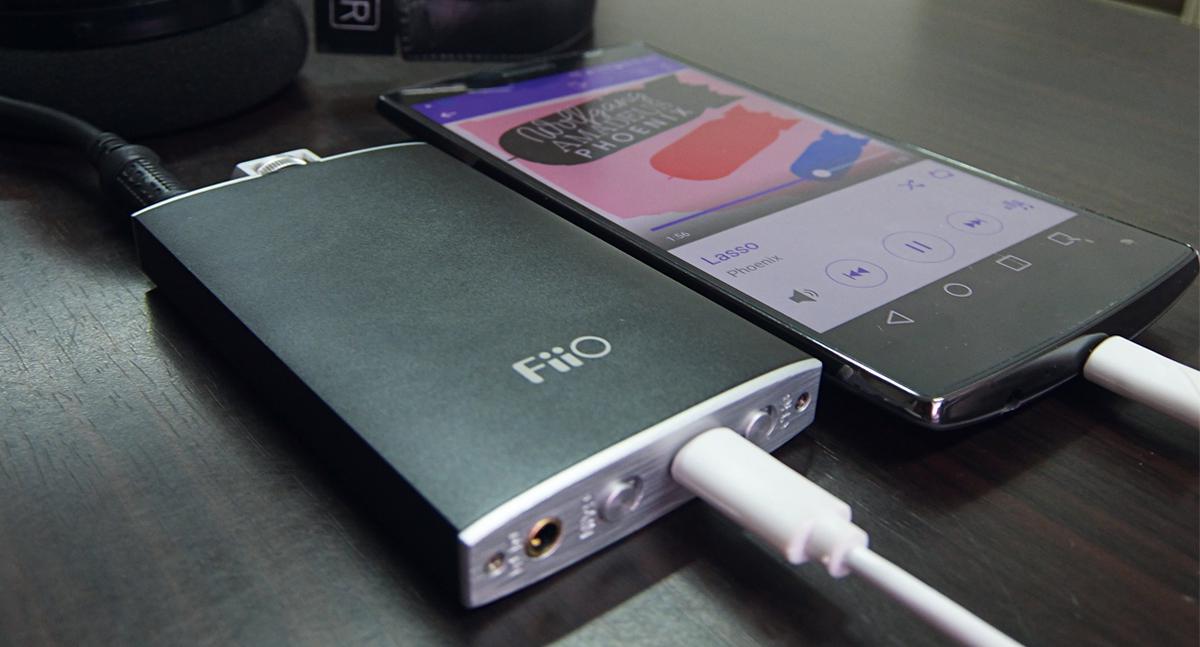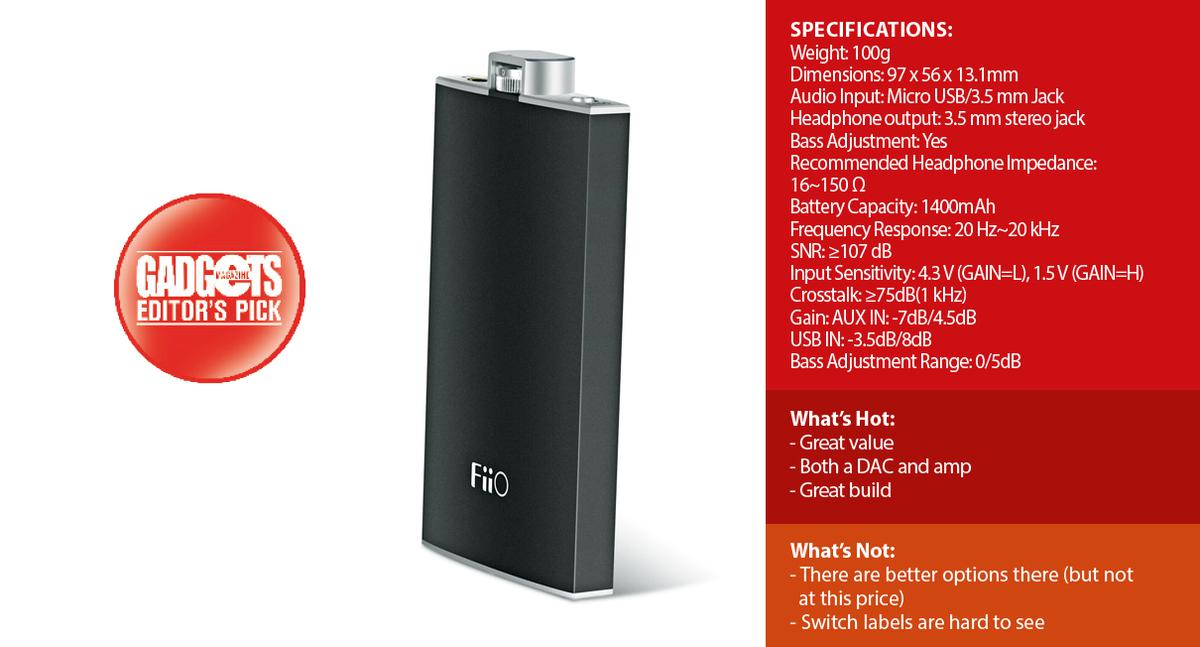Music is one of life’s greatest gifts. If I had the resources, I would have Lana del Rey follow me around, singing songs appropriate to the situation at hand. Alas, I’m but a poor writer, so I have to settle for music from my mobile device. This does the job most of the time, but even with a good pair of headphones, sometimes, the sound quality available from our smartphone just isn’t enough. Enter Fiio, one of the best-received budget audio brands of late. I managed to get my hands on a Fiio Q1 pocket amp/DAC to review. Here’s what I heard.
Design: 4.0/5.0
The Q1 is a small device, about the size of some of the currently available feature phones, though thinner by a fair bit. It’s got an aluminum body with plastic ends where the inputs and outputs reside, and a volume dial/on switch knob at the top. It’s convexed out slightly, giving it all the appearance of a flask. It fits the hand very well, and is a lot lighter than it looks. The body is a matte black with silver trim, so it will blend easily with your suite of gadgets. Flanking the volume/power knob are the bass boost switch on the right, the headphone out jack on the left, and a little power and charging indicator LED beside that. The bottom has the microUSB port for charging and Digital Audio in, with the charging cutoff switch to one side, and the gain switch and line in/line out port.
The device also somes with a few extras in the box, including two rubber bands, two silicone pads, a short male-male 3.5-3.5 audio cable, and a microUSB cable for charging—basically everything you need to stack.
Hardware: 3.5/5.0
While it’s not really something that’s meant to compete with pocket DACs and amps many times its price, the Q1 does have a decent bit of hardware for its price point. With the Texas Instruments PCM5102 handling decoding, and a Maxim MAX97220 for amping, this is a great, cost-effective solution to an equally cost-effective pocket DAC/amp combo. According to users, this should be enough to drive headphones to 150 Ohms with no problem. The Q1 is powered by an internal 1400mAh battery, which is rated to provide upwards of 30 hours of use.
User Experience: 4.0/5.0
I had been hearing a lot about Fiio’s audio devices, mostly good, so, wanting to see what all the hype was about, I decided to take the plunge with the Q1, the latest from the manufacturer, that offered great performance at an even greater price. I was looking for a bit more clarity than my devices could give with their own audio processing chips, and still be portable, so a pocket DAC/Amp was the obvious choice. I found a great deal on the Q1, picked it up, and eagerly ran back to the office for a quick listen. There is little to no setup required for the Q1. Pick it up, connect it to your device’s headphone out jack, plug your headphones into the Q1, and you’re off. I was listening with my Grado SR80i, an easy-to-drive pair of open headphones that on their own offer a great soundstage. With the Q1, there was quite a noticeable difference. The sound opened up noticeably, putting you right in there in the performance. The Q1 also woke the bass up quite a bit. The SR80i isn’t really known for its bass performance, but even with bass boost off, there was quite a marked improvement. The heavy bass sounds were also tighter, and much more enjoyable to listen to. I’m not too fond of bass-heavy audio, so I found that turning it on was just a little too much, getting slightly in the way of the mids I work so hard to chase. It also tames the higher mids present on some brighter cans, making it a little less tiring on the ears.
Vocals come out beautifully, and very clean. The Q1 is also really quiet. With a pair of Jabra Evolve 80s that offer great isolation on their own, the Q1 is, as far as I can tell, completely free of any buzzing on its own. With no music playing, it’s just peaceful, black silence, which is remarkable for a device such as this. It’s not mind-blowing in its performance, but it’s way more than I expected from a device at this prince point.
Another thing that really makes the Q1 shine, particularly for the price of admission, is the ability to accept a digital source via microUSB. This was the main feature that had me sold on the Q1, as I intended to use it with a smartphone (though it should also work with your desktop/laptop as an external soundcard). Paired with my LG G3, a microUSB to microUSB cable, and some nice lossless music, you can skip your device’s internal audio hardware, and leave the decoding and amping up to the Q1. Since it’s a dedicated device, it’s almost certainly going to do a better job than the tiny chip on your mobile device, plus eliminate the double amping that would happen if you plugged the Q1 into the audio jack of your music player. If your smartphone gives you a slight buzz, or interference from the jack, this is the answer you’ve been waiting for. The clean digital signal can be fed to the Q1’s own amp, then to your headphones via the jack at the top of the device, or you can skip that and just use the Q1 as a DAC and feed an analog signal out the bottom jack, for another standalone amp, if you so choose. Just be warned that not all devices are supported, so make sure your device can do digital out via a USB port if this is what you’re after.
Value: 4.5/5.0
I had been eyeing a pocket amp for some time now, if only to better reach the performance of my favorite headphones. Most of the options were just a little too steep for a device I didn’t absolutely need, and the less expensive alternatives seemed like they didn’t do enough of what I was looking for. This is a great balance of performance and cost. While it’s not the absolute best pocket amp you’re going to find, it’s worlds better than the price point would suggest. The fact that it’s both a DAC and pocket Amp just makes the price of admission (less than PHP 4,000) all that much more worth it.

Bottomline:
If you’re looking to get more from your headphones, but don’t want to go overboard just yet, this is a great place to start.
Also published in December 2015 to January 2016 Issue
Words by Ren Alcantara
